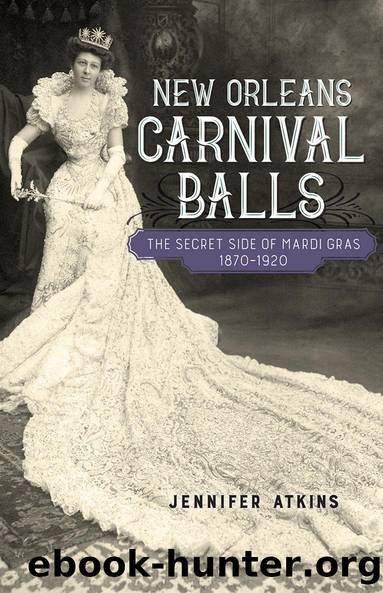New Orleans Carnival Balls by Jennifer Atkins

Author:Jennifer Atkins [Atkins, Jennifer]
Language: eng
Format: epub
Tags: History, United States, State & Local, South (AL; AR; FL; GA; KY; LA; MS; NC; SC; TN; VA; WV), Social Science, Customs & Traditions, Holidays (Non-Religious), Gender Studies, Regional Studies
ISBN: 9780807167571
Google: XIiPDgAAQBAJ
Publisher: LSU Press
Published: 2017-09-13T22:17:54+00:00
âEmblem of the Mysterious.â New Orleans Daily Picayune, January 4, 1900.
The quadrille developed from seventeenth-century square dances popular throughout Europe. Whereas British square dances became âlongways for as many willâ (two lines that extended as far as space allowed, with one partner in each line, facing each other), French square dance formations consisted of only a few couples, usually four or eight.98 The French-style quadrille emphasized patterned exchanges between partners that remained within the space of the square. English dances, on the other hand, used a âcasting offâ method wherein dancers began in one spot and moved to the back of the line. The dance ended when dancers regained their original positions. Whether English or French, quadrilles relied on geometrically patterned phrases strung together to make a full dance, similar to the grand march.99 By the mid-nineteenth century, these patterns settled into a format that included only a handful of phrasesâusually a five-pattern series for each dance.100 Within the next few decades, the movement (once full of complex and constantly changing footwork, mostly turns, jumps, and slides) gave way to easy promenades and interweaving lines of dancers that engaged in a gentle, gliding walk.101 The quadrille retained its stately air but became more accessible for the growing number of people striving for gentility.
The quadrille was a status symbol. American and European genteel society considered it to be the âmost universally approved of all the fashionable dances. . . . Among all the various dances that have been introduced, the Quadrille holds a high position.â102 Status accompanied the quadrille because it allowed the cream of society to stand apart as refined dancers while also creating a space for them to mingle only with each other. Only the highest-ranking guestsâfor Carnival balls, that meant mock royaltyâdanced the first quadrille at a ball. Quadrilles were, as one manual pointed out, âalways appropriated by the aristocratic element.â103
Download
This site does not store any files on its server. We only index and link to content provided by other sites. Please contact the content providers to delete copyright contents if any and email us, we'll remove relevant links or contents immediately.
Cecilia; Or, Memoirs of an Heiress — Volume 1 by Fanny Burney(31444)
Cecilia; Or, Memoirs of an Heiress — Volume 3 by Fanny Burney(31035)
Cecilia; Or, Memoirs of an Heiress — Volume 2 by Fanny Burney(30982)
The Great Music City by Andrea Baker(22896)
We're Going to Need More Wine by Gabrielle Union(18125)
Bombshells: Glamour Girls of a Lifetime by Sullivan Steve(13157)
Pimp by Iceberg Slim(12999)
All the Missing Girls by Megan Miranda(12834)
Fifty Shades Freed by E L James(12491)
Talking to Strangers by Malcolm Gladwell(11984)
Norse Mythology by Gaiman Neil(11961)
Crazy Rich Asians by Kevin Kwan(8410)
Mindhunter: Inside the FBI's Elite Serial Crime Unit by John E. Douglas & Mark Olshaker(7897)
The Lost Art of Listening by Michael P. Nichols(6532)
Enlightenment Now: The Case for Reason, Science, Humanism, and Progress by Steven Pinker(6447)
Bad Blood by John Carreyrou(5816)
The Four Agreements by Don Miguel Ruiz(5577)
Weapons of Math Destruction by Cathy O'Neil(5095)
We Need to Talk by Celeste Headlee(4920)
